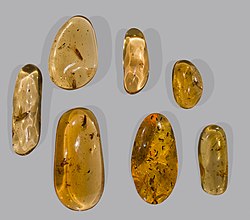Portal:Paleontology
|
The Palaeontology Portal
Introduction Paleontology (/ˌpeɪliɒnˈtɒlədʒi, ˌpæli-, -ən-/ PAY-lee-on-TOL-ə-jee, PAL-ee-, -ən-), also spelled palaeontology or palæontology, is the scientific study of life that existed prior to the start of the Holocene epoch (roughly 11,700 years before present). It includes the study of fossils to classify organisms and study their interactions with each other and their environments (their paleoecology). Paleontological observations have been documented as far back as the 5th century BC. The science became established in the 18th century as a result of Georges Cuvier's work on comparative anatomy, and developed rapidly in the 19th century. The term has been used since 1822 formed from Greek παλαιός ('palaios', "old, ancient"), ὄν ('on', (gen. 'ontos'), "being, creature"), and λόγος ('logos', "speech, thought, study"). Paleontology lies on the border between biology and geology, but it differs from archaeology in that it excludes the study of anatomically modern humans. It now uses techniques drawn from a wide range of sciences, including biochemistry, mathematics, and engineering. Use of all these techniques has enabled paleontologists to discover much of the evolutionary history of life, almost back to when Earth became capable of supporting life, nearly 4 billion years ago. As knowledge has increased, paleontology has developed specialised sub-divisions, some of which focus on different types of fossil organisms while others study ecology and environmental history, such as ancient climates. (Full article...) Selected article on the prehistoric world and its legacies
Edmontosaurus is a genus of crestless duck-billed dinosaur. The fossils of this animal have been found in rocks of western North America that date from the late Campanian stage to the end of the Maastrichtian stage of the Cretaceous Period, between 73 and 65.5 million years ago. It was one of the last non-avian dinosaurs, and lived shortly before the Cretaceous–Paleogene extinction event. Edmontosaurus was one of the largest hadrosaurids, measuring up to 13 meters (43 ft) long and weighing around 4.0 metric tons (4.4 short tons). It is known from several well-preserved specimens that include not only bones, but in some cases extensive skin impressions and possible gut contents.
Edmontosaurus has a lengthy and complicated taxonomic history dating to the late 19th century. The type species, E. regalis, was named by Lawrence Lambe in 1917, although several other species that are now classified in Edmontosaurus were named earlier. The best known of these is E. annectens, originally named by Othniel Charles Marsh in 1892. Edmontosaurus was widely distributed across western North America. The distribution of Edmontosaurus fossils suggests that it preferred coasts and coastal plains. It was an herbivore that could move on both two legs and four. Because it is known from several bone beds, Edmontosaurus is thought to have lived in groups, and may have been migratory as well. (see more...) Did you know?

General images -The following are images from various paleontology-related articles on Wikipedia.
Selected article on paleontology in human science, culture and economicsGould's most significant contribution to evolutionary biology was the theory of punctuated equilibrium, which he developed with Niles Eldredge in 1972. The theory proposes that most evolution is marked by long periods of evolutionary stability, which is punctuated by rare instances of branching evolution. The theory was contrasted against phyletic gradualism, the popular idea that evolutionary change is marked by a pattern of smooth and continuous change in the fossil record. Most of Gould's research was based on the land snail genera Poecilozonites and Cerion. He also contributed to evolutionary developmental biology, and has received wide praise for his book Ontogeny and Phylogeny. In evolutionary theory he opposed strict selectionism, sociobiology as applied to humans, and evolutionary psychology. Gould was known by the general public mainly from his 300 popular essays in the magazine Natural History, and his books written for a non-specialist audience. In April 2000, the US Library of Congress named him a "Living Legend". (see more...) On this day...June 5:
A New Basal Hadrosauroid Dinosaur (Dinosauria: Ornithopoda) with Transitional Features from the Late Cretaceous of Henan Province, China Hai Xing, Deyou Wang, Fenglu Han, Corwin Sullivan, Qingyu Ma, Yiming He, David W. E. Hone, Ronghao Yan, Fuming Du, Xing Xu published 05 Jun 2014 Selected image
CategoriesTopicsGeneral - Paleontology - Fossil - Evolution - Extinction Quality ContentFeatured paleontology articles
- Achelousaurus
- Acrocanthosaurus
- Albertosaurus
- Allosaurus
- Amargasaurus
- Ankylosaurus
- Apatosaurus
- Archaeopteryx
- Baryonyx
- Carnotaurus
- Catopsbaatar
- Ceratosaurus
- Chicxulub Crater
- Compsognathus
- Cretaceous–Tertiary extinction event
- Daspletosaurus
- Deinocheirus
- Deinonychus
- Deinosuchus
- Dilophosaurus
- Dinosaur
- Diplodocus
- Dromaeosauroides
- Edmontosaurus
- Elasmosaurus
- Giganotosaurus
- Gorgosaurus
- Herrerasaurus
- Iguanodon
- Istiodactylus
- Lambeosaurus
- List of dinosaur genera
- Majungasaurus
- Massospondylus
- Megalodon
- Nemegtomaia
- Nigersaurus
- Opisthocoelicaudia
- Paranthodon
- Parasaurolophus
- Plateosaurus
- Psittacosaurus
- Seorsumuscardinus
- Spinosaurus
- Stegosaurus
- Stegoceras
- Styracosaurus
- Tarbosaurus
- Thescelosaurus
- Triceratops
- Tyrannosaurus
- Velociraptor
Things you can doCurrent Paleontology FACs - None yet... WikiProjectsRelated portalsAssociated WikimediaThe following Wikimedia Foundation sister projects provide more on this subject:
Discover Wikipedia using portals |








































